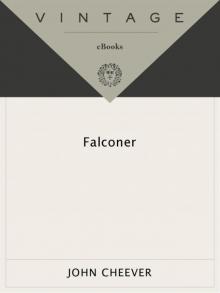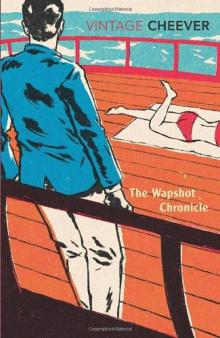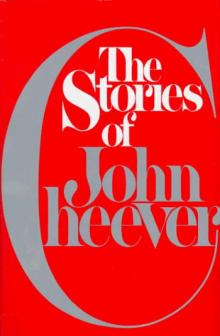- Home
- John Cheever
The Wapshot Scandal
The Wapshot Scandal Read online
JOHN CHEEVER
The Wapshot
Scandal
WITH A FOREWORD BY
Dave Eggers
Contents
Cover
Title
Copyright
Dedication
About the Author
Also by John Cheever
Foreword
Part One
Chapter I
Chapter II
Chapter III
Chapter IV
Chapter V
Chapter VI
Chapter VII
Chapter VIII
Chapter IX
Chapter X
Chapter XI
Chapter XII
Chapter XIII
Chapter XIV
Chapter XV
Chapter XVI
Chapter XVII
Part Two
Chapter XVIII
Chapter XIX
Chapter XX
Chapter XXI
Chapter XXII
Chapter XXIII
Chapter XXIV
Chapter XXV
Chapter XXVI
Chapter XXVII
Part Three
Chapter XXVIII
Chapter XXIX
Chapter XXX
Chapter XXXI
Chapter XXXII
This eBook is copyright material and must not be copied, reproduced, transferred, distributed, leased, licensed or publicly performed or used in any way except as specifically permitted in writing by the publishers, as allowed under the terms and conditions under which it was purchased or as strictly permitted by applicable copyright law. Any unauthorised distribution or use of this text may be a direct infringement of the author’s and publisher’s rights and those responsible may be liable in law accordingly.
Version 1.0
Epub ISBN 9781407072777
www.randomhouse.co.uk
Published by Vintage 1998
2 4 6 8 10 9 7 5 3 1
Copyright © John Cheever 1959, 1961, 1962, 1963, 1964
Foreword copyright © Dave Eggers 2003
John Cheever has asserted his right under the Copyright, Designs and Patents Act 1988 to be identified as the author of this work
Six parts of this book appeared in The New Yorker and one in Esquire and the author is grateful to the editors for their permission to reprint
This book is sold subject to the condition that it shall not, by way of trade or otherwise, be lent, resold, hired out, or otherwise circulated without the publisher’s prior consent in any form of binding or cover other than that in which it is published and without a similar condition, including this condition, being imposed on the subsequent purchaser
First published in Great Britain by Harper in 1964 First published by Vintage in 1998
Vintage
Random House, 20 Vauxhall Bridge Road,
London SW1V 2SA
www.vintage-classics.info
Addresses for companies within The Random House Group Limited can be found at: www.randomhouse.co.uk/offices.htm
The Random House Group Limited Reg. No. 954009
A CIP catalogue record for this book is available from the British Library
ISBN 9780099275282
To W.M.
THE WAPSHOT SCANDAL
John Cheever was born in Quincy, Massachusetts, in 1912, and went to school at Thayer Academy in South Braintree. He is the author of seven collections of stories and five novels. His first novel, The Wapshot Chronicle, won the 1958 National Book Award. In 1965 he received the Howells Medal for Fiction from the National Academy of Arts and Letters and in 1978 he won the National Book Critics Circle Award and the Pulitzer Prize. Shortly before his death in 1982 he was awarded the National Medal for Literature.
ALSO BY JOHN CHEEVER
Novels
The Wapshot Chronicle
Falconer
Bullet Park
Oh What a Paradise It Seems
Short Stories
The Way Some People Live
The Enormous Radio
The Housebreaker of Shady Hill
Some People, Places and Things
That Will Not Appear in My Next Novel
The Brigadier and the Golf Widow
The World of Apples
The Stories of John Cheever
Journals
The Journals
Letters
The Letters of John Cheever (edited by Benjamin Cheever)
All the characters in this work are fictional, as is much of the science.
FOREWORD
A Foreword by a non-Cheever-scholar and infrequent reader of forewords:
I don’t know how certain books become canonical and others don’t. I know nothing about how these things work, what committees are formed, consulted, and what powers they wield, but I picture the process like a Pachinko. The book, playing the part of the silver lead ball – stay with me here – is sent through the top of the machine – the literary-cultural-academic machine – and it tinkles back and forth, subjected to popular and critical reaction, to revisionist theory, to changes in taste over a period of time, and eventually, if all goes well, it scores some points and stays in play. (I guess maybe I should have used a pinball metaphor. Your thoughts? Send them to 826 Valencia Street, San Francisco, CA 94110. Thank you in advance.)
For whatever reason, Cheever’s stories, which are not superior to this novel and its predecessor, are remembered better than the Wapshots, but there is no clear way to explain why. Did the first Wapshot book not win the National Book Award? It did win that. Are these novels lacking in scope? Not a bit. Are they not representative of the human condition at a juncture in time? They are. Are they convincing? They are. Are they beautiful? They are so filled with love that it’s hard to believe that a man wrote these sentences, and not some kind of freakish winged book-writing angel-beast or something. And finally: Are these just short stories stretched to novel length? Not at all.
The Wapshot Scandal is very much a fully realized novel, and not only is it masterfully paced and exquisitely written but it’s also adherent to the best aspect of the novel form: its willingness to be big, messy, sprawling, and meandering. Though Cheever is never out of control – his command of his always perfect sentences and paragraphs is uninterrupted – he does make some very loose decisions. Scandal is not tidy, and few if any of the characters come out, in the end, changed in any fundamental way. One dies, and one begins drinking heavily, but otherwise there are no great and articulated epiphanies. Best of all, a number of secondary characters are introduced and developed and then never find their way back into the narrative. The book does not end in a way that would be satisfying to readers expecting closure, and this makes the book not craft but art.
That must be what some of us fear with Cheever, or with what we assume about Cheever: that his work will be ‘exquisite’ or ‘carefully crafted.’ (And I do believe I used the word ‘exquisite’ just a short while ago. And for that I’m sorry.) That it’s of small scope but ‘masterful in style.’ Something like that – like a toy boat on a small man-made pond. But I think what this book, as one example, demonstrates, is that Cheever is the blessedly craziest and most passionate kind of artist. This book is a breathless burst of a thing, no matter how long it took to write (and I have no idea how long that was, though Cheever’s Wapshot Chronicle is thought to have taken twenty years). However long it took – and that’s pretty much irrelevant, always – Scandal is one of the most fluid and riveting things written in the last fifty years, and it, yes, it showcases Cheever’s ridiculously visceral feeling for the human animal.
The best books are hits of nitrous – you suck them in, they give you a warm wa-wa feeling for awhile, and when you
’re done, you go looking for more. (That is, if you’re that sort of person, a parking-lot person, eating a grilled cheese with one hand and looking for a miracle with the other. And I am not that person, except one time, in Durham, North Carolina, c. 1991.) The best books, I want to say, relight the world; they take the flaccid balloon of time, place, and character and breathe into it until the thing is about to pop. And this much is true: Cheever has amazing lungs.
Here’s an example. It takes place when Melissa, the somewhat disillusioned but lusty wife of Moses Wapshot, is at the florist and overhears another customer ordering flowers for a dead relative:
‘I guess I’m the closest she has left,’ he said confusedly, and Melissa, waiting for her roses, felt a premonition of death. She must die — she must be the subject of some such discussion in a flower shop, and close her eyes forever on a world that distracted her with its beauty. The image, hackneyed and poignant, that to her was of life as a diversion, a festival from which she was summoned by the secret police of extinction, when the dancing and the music were at their best. I do not want to leave, she thought. I do not ever want to leave.
This is of course how we feel while reading The Wapshot Scandal – it’s so good in here we don’t want to leave, even though the lives of these people are not, at all, intrinsically interesting. Maybe only Cheever can acknowledge the mundanity of suburban existence, keep his characters firmly rooted in the soil of that world, and yet give them souls that soar. Every major character in Scandal is bored in some fundamental way, and instead of moping or griping or justfalling apart – the m.o. of nearly all of our American suburban heroes – they act boldly against the quietly oppressive machinery around them. They flee the IRS, they philander in the most breathtaking ways, they feed Keats into a supercomputer, they give up everything they have, again and again.
As many of the most staid-seeming of Wapshot’s standard-bearers leave St. Botolphs, the book follows them through the Southwest and Europe, and Cheever’s perceptions are no less acute when he’s trailing their progress around the world. Early on, we’re introduced to an IRS agent named Norman Johnson, who is about to change the venerable Honora Wapshot’s life irrevocably and send her on a journey of her own. But when we meet him, he is staying at a hotel in St. Botolph’s, and Cheever uses Johnson’s time there to elucidate the price of travel, setting the tone for all the wandering and searching to come:
[Johnson] was a traveler, familiar with the miseries of loneliness, with the violence of its sexuality, with its half-conscious imagery of highways and thruways like the projections of a bewildered spirit; with that forlorn and venereal limbo that must have flowed over the world before the invention of Venus, unknown to good and evil, ruled by pain.
So we know that Cheever writes beautifully and with as much lust for words and life as anyone this country has yet produced (I said it, you didn’t). But he’s also funny. I’ll leave you with one of the funniest lines written in our language, and it’s all the funnier for when it was written, in the darkest shadow of possible atomic Armageddon. It occurs in a passage about Coverly’s boss, Dr. Cameron, a nuclear scientist and the director of a massive government research center, who stands in as a sort of passive, crazed God-among-us. He is at once brilliant, broken, and powerful enough to destroy the world many times over. (This book is very much a Cold War book – confused and terrified by atomic energy, by knowing so little about it, its makers, its wielders.) Cameron is a widower and has a mistress he visits in Rome; he flies there as often as he can. He must see her in Rome because to do so in the United States would be scandalous, but – and soon we’ll get to the line in question, couched between em dashes: ‘There was a legitimate side to these trips — the Vatican wanted a missile — and a side more clandestine than his erotic sport.’
Anyway. I thought it was funny. Please read this book.
Dave Eggers, December 2002
PART
ONE
CHAPTER I
The snow began to fall into St. Botolphs at four-fifteen on Christmas Eve. Old Mr. Jowett, the stationmaster, carried his lantern out onto the platform and held it up into the air. The snowflakes shone like iron filings in the beam of his light, although there was really nothing there to touch. The fall of snow exhilarated and refreshed him and drew him—full-souled, it seemed—out of his carapace of worry and indigestion. The afternoon train was already an hour late, and the snow (whose whiteness seems to be a part of our dreams, since we take it with us everywhere) came down with such open-handed velocity, such swiftness, that it looked as if the village had severed itself from its context on the planet and were pressing its roofs and steeples up into the air. The remains of a box kite hung from the telephone wires overhead—a reminder of the year’s versatility. “Oh, who put the overalls in Mrs. Murphy’s chowder?” Mr. Jowett sang loudly, although he knew that it was all wrong for the season, the day and dignity of a station agent, the steward of the town’s true and ancient boundary, its Gate of Hercules.
Going around the edge of the station he could see the lights of the Viaduct House, where at the very moment a lonely traveling salesman was bending down to kiss a picture of a pretty girl in a mail-order catalogue. The kiss tasted faintly of ink. Beyond the Viaduct House were the rectilinear lights of the village green, but the village itself was circular and did not conform in any way to the main road that wound seaward to Travertine, or to the railroad track, or even to the curve of the river, but to the pedestrian needs of its inhabitants, putting them within walking distance of the green. Thus it was the shape, really, of an ancient place, and seen from the air on a fairer day might have been in Etruria. Mr. Jowett could see into the windows, across from the Viaduct House and above the ship chandler’s, of the Hastings apartment, where Mr. Hastings was decorating the Christmas tree. Mr. Hastings stood on a ladder, and his wife and children passed him ornaments and told him where to hang them. Then suddenly he bent and kissed his wife. It was the sum of his feeling for the holiday and for the storm, Mr. Jowett thought, and it made him very happy. He seemed to feel happiness in the stores and houses, happiness everywhere. Old Dog Tray trotted happily up the street, on his way home, and Mr. Jowett thought affectionately of the dogs of St. Botolphs. There were wise dogs, foolish dogs, bloodthirsty and thieving dogs, and as they raided clotheslines, upset garbage pails, bit the mailman and disturbed the sleep of the just, they seemed like diplomats and emissaries. They seemed, in their chaffing way, to keep the place together.
The last of the shoppers were going home, carrying a pair of mittens for the ash man, a brooch for Grandmother and a Teddy bear stuffed with sawdust for baby Abigail. Like Old Dog Tray, everybody was going home, and everybody had a home to go to. It was one place in a million, Mr. Jowett thought. Even with his pass, he had never wanted much to travel. The village, he knew, had, like any other, its brutes and its shrews, its thieves and its perverts, but like any other it meant to conceal these facts under a shine of decorum that was not hypocrisy but a guise or mode of hope. At that hour most of the inhabitants were decorating their Christmas trees. The druidical significance of bringing a green tree into the house at the solstice had certainly never crossed the minds of any of the natives, but they treated their chosen trees (at the time of which I’m writing) with more instinctive respect than is the case today. The trees were not, at the end of their usefulness, stuck into ashcans or fired into the ditch by the railroad tracks wearing a few strands of angel’s hair. The men and boys burned them ceremoniously in the back yard, admiring the surge of flame and the smell of balsam smoke. People did not, as they presently would, say that the Tremaines’ tree was skinny, that the Wapshots’ tree had a bare place in the middle, that the Hastings’ tree was stumpy and that the Guilfoyles must have suffered economic reverses, since they had only paid fifty cents for their tree. Fancy illuminations, competitiveness and disregard for the symbols involved would all come, but they would come later. The lights, at the time of which I am writing, were spare and rud
imentary and the ornaments were commemorative like the table silver, and were handled respectfully, as if one were counting over the bones of the family. They were, naturally, in disrepair—the birds without tails, the bells without clappers and the angels sometimes without wings. It was a conservatively dressed population that performed this tree-trimming ceremony. All the men wore trousers and all the women wore skirts, excepting Mrs. Wilston, who was a widow, and Alby Hooper, who was an itinerant carpenter. They had been drinking bourbon for two days and wore nothing at all.
On the ice pond—Parson’s Pond at the north end of town—two boys were struggling to keep clear enough ice for a hockey game in the morning. They skated back and forth, pushing coal shovels ahead of them. It was an impossible task. This was clear to both of them, and yet they continued to go back and forth, toward and away from the roar of the falls at the dam, with an unaccountable feeling of eagerness. When the snow got too deep for skating, they propped their shovels against a pine tree and sat down in its shelter to unlace their skates.
“You know, Terry, I miss you when you’re away at school.”
“They throw so much work at me in school that I don’t have a chance to miss anyone.”
“Smoke?”
“No, thanks.”
The first boy took from his pocket a pouch full of sassafras root that had been ground in a clean pencil sharpener, poured some of this onto a square of coarse, yellow toilet paper, and rolled a loose cigarette that flared up like a torch, lighting his thin face, with its momentary look of suavity, and dropping embers all over his trousers. Drawing on his cigarette, he could taste its components—the raw gassy flavor of burning toilet paper and the sweetness of sassafras. He shuddered as it touched his lungs, and yet he was rewarded by his smoke with a sense of wisdom and power. When their skates were unlaced and the fire in the cigarette had died, they started back toward the village. The first house they passed was the Ryders’, distinguished in St. Botolphs because, for as long as anyone could remember, the parlor window shades had been drawn and the parlor door locked. What did the Ryders have hidden in their parlor? There was no one in the village who hadn’t wondered. Was there a dead body there, a perpetual-motion machine, a collection of eighteenth-century furniture, a heathen altar, a laboratory for hellish experiments on dogs and cats? People had made friends of the Ryders in the hope of getting into their parlor, but no one had ever succeeded. The Ryders themselves, a peculiar but not really unfriendly family, were decorating their tree in the dining room, which was where they lived. Next to the Ryders’ was the Tremaines’ and, passing here, the boys could see a gleam of something yellow—copper or brass—a clue to the richness of color in that house. Traveling through Persia as a young man, Dr. Tremaine had cured the shah of boils and had been rewarded with rugs. The Tremaines had rugs on their tables, their piano, their walls and their floors, and the brilliant dyes could be seen through the lighted windows. Suddenly, for one of the boys—the smoker—the bitterness of the storm and the warmth of color in the Tremaines’ house seemed to converge. It was like a discovery, and so exciting that he began to run. His friend jogged along beside him to the corner, where they could hear the bells of Christ Church.
-->

 The Wapshot Scandal
The Wapshot Scandal The Stories of John Cheever
The Stories of John Cheever Bullet Park
Bullet Park Falconer
Falconer The Journals of John Cheever
The Journals of John Cheever Oh What a Paradise It Seems
Oh What a Paradise It Seems Scott Donaldson
Scott Donaldson The Wapshot Chronicle
The Wapshot Chronicle The Stories of John Cheever (1979 Pulitzer Prize)
The Stories of John Cheever (1979 Pulitzer Prize)